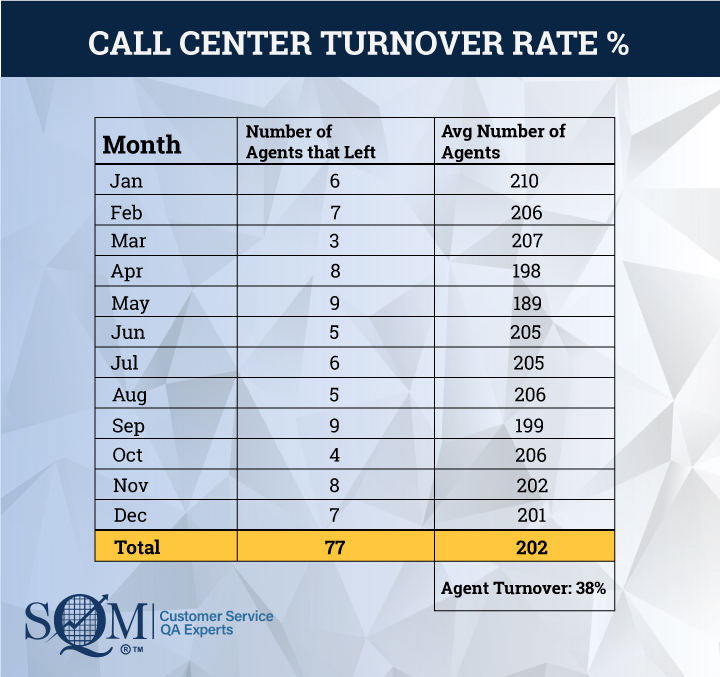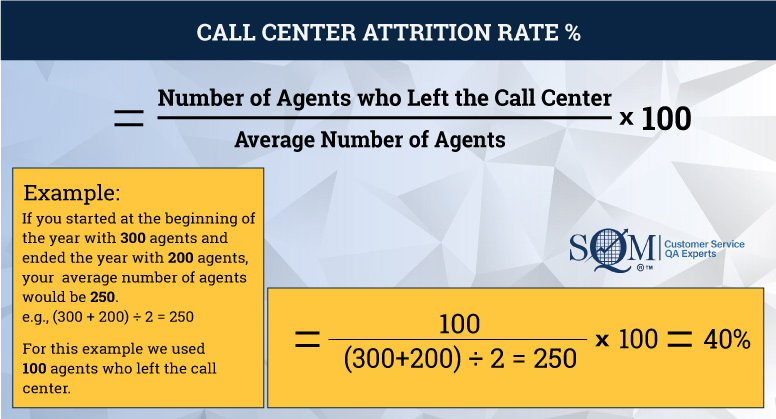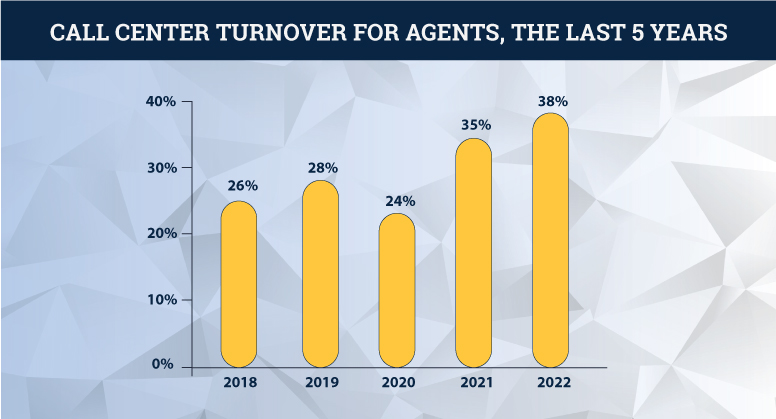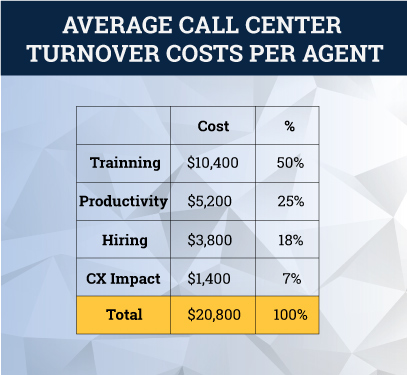Call Center Turnover
If you ask C-level leaders of a company what is the key performance indicator (KPI) for determining if the call center is operating effectively and efficiently, most will say service level, some will say customer satisfaction, and even fewer will say First Call Resolution. But in the pandemic era, are those KPIs the most important? That is not to say these KPIs are not important; they are, but maybe it's time to shift focus to call center turnover as the most important KPI.
The quiet quitting and great resignation in 2022 have brought us a seemingly-endless onslaught of call center issues, such as poor customer experience (CX) and higher operating costs. In addition, recent SQM Group research shows that 47% of managers feel their biggest problem operating a call center effectively and efficiently is high agent turnover and absenteeism.
According to SQM's CX research, First Call Resolution (FCR) and Customer Satisfaction (Csat) for the call center industry significantly decreased in 2022. SQM also believes that the number one problem in 2022 to achieving a high call center Csat and FCR rate is the historically high agent turnover rate of 38%, and there are no signs of slowing down the employee turnover rate any time soon.
The high agent turnover percentage is staggering, but they don't tell the entire story. SQM's 2022/23 benchmarking data shows some call centers have agent turnover as low as 20% and as high as over 200%. In addition, compounding the agent turnover issue is that 81% of agents prefer the work-from-home model (WFH), 16% want the hybrid model, and only 3% prefer the call center. By all accounts, the WFH model has been one of the main contributors to high agent turnover.
As a result of the higher agent turnover, job burnout, absenteeism, operating cost, and lower FCR and Csat, you can strongly argue that call center turnover is the most important KPI. This belief is because call center turnover KPI is crucial for helping manage a call center's operating practices efficiently and effectively.
Reducing call center attrition or turnover rates can be extremely challenging, especially considering there is no single root cause that is driving low agent retention. This blog is a comprehensive guide to help call center leaders reduce call center turnover in order to improve FCR, Csat, and operating costs. The blog will cover the differences between call attrition and turnover rate, how to calculate attrition and turnover, benchmarks, why turnover is high, why turnover matters, and tactics to improve retention.
What Is Call Center Turnover Rate?
The call center turnover rate metric measures the percentage of agents who leave out of the total workforce for a given period or year. Specifically, the call center turnover rate is based on the number of agents who left the call center, whether internally or externally, but the company hired new agents to replace those who left and the total number of agents.
Moreover, SQM Group's research shows for the majority of call centers, 25% or less of agents who left the call center went to work in another department (e.g., internally) within a company. Put differently, the majority of agent turnover is external (75% or more).
How To Calculate Call Center Turnover Rate?
As the old saying goes, "you can't improve it unless you measure it." In order to measure the call center turnover rate, it's helpful to use the right calculation. A common calculation method used is the number of agents that left the call center divided by the average number of agents working in the call center, which includes new hires.
For example, the below table shows the total annual number of agents that left the call center was 77 divided by the average number of agents working in the call center was 202 (total/12) = Call Center Agent Turnover Rate of 38%.

What Is Call Center Attrition Rate?
The call center attrition rate metric measures the percentage of agents who leave out of the total workforce for a given period or year. The difference from the call center turnover rate is the attrition rate metric is that the company does not hire a replacement. The call center attrition term is also referred to as agent churn.
In addition, the call center attrition rate metric provides insights into how long agents work for a call center and how often they leave. Agent attrition is a major challenge in the call center industry. In fact, call centers have some of the highest employee attrition of any type of business function and industry type.
How To Calculate Call Center Attrition Rate?
A common calculation method used is the number of agents that left the call center divided by the average number of agents. If you started at the beginning of the year with 300 agents and ended the year with 200 agents, your average number of agents would be 250 (e.g., 300 + 200 ÷ 2 = 250). In addition, for the below example, we used 100 agents who left the call center.
For example, the below infographic shows the call center attrition rate calculation would be 100 (agents who left) divided by 250 (average # of agents based at the 300 beginning & 200 End of year / 2 ) X 100 = Call Center Attrition Rate of 40%.

Call Center Turnover Benchmarks
The U.S. unemployment rate for 2022 was 3.7%, a 1.8 percentage point decline from the 2021 unemployment rate of 5.5%. The unemployment rate for 2021 had a 2.6 percentage point decline from the 2020 unemployment rate of 8.1%, which had increased by 4.4 percentage points from 2019.
With such low unemployment, agent job dissatisfaction, and the WFH model making it easy for agents to job-hop, it is no surprise that call center turnover is high. The average call center agent turnover was 35% in 2021 and 38% in 2022, which is the highest rate we have ever seen. In addition, the 2022 agent turnover is an astonishing 58% higher than in 2020, the year most agents transitioned to the WFH model. Based on call center turnover for the last two years, the industry standard for call center turnover is 30 to 40 percent.
Call center turnover has been increasing over the last five years. Prior to 2018, call center turnover was under 25% and fairly stable. In addition, it was common for call centers during this time to have a call center turnover goal of 20%, and many of them were able to achieve this target. In a pandemic era, a good call center turnover goal is 30% or less.

It is very likely that in 2023, agent turnover will remain high. There are several reasons why agents have low job satisfaction, reduced engagement, or quit. First, it is essential to mention that most call center managers know low agent job satisfaction and engagement can lead to agents reducing their effort. In addition, agents can get psychologically detached from their jobs (i.e., quiet quitting) or quit to work elsewhere.
Our recent poll with call center practitioners showed that 76% agree that agents are burnt out working in the call center, which is much higher in 2022 than in past years. Therefore, it is no surprise that agent turnover in the call center industry is at an all-time high.
Root Cause Themes Why Agents Quit:
- Overall job dissatisfaction working in a call center
- Low unemployment rate and the WFH model provide more options to job hop
- Government financial assistance is available for individuals not working
- Undesirable work schedule, repetitive work, and being confined to a desk
- Poor career opportunities, skills underutilized, and limited skills development
- Not appreciated or valued and not enough motivation, recognition, and rewards
- Personality conflicts with supervisors, poor supervisor coaching skills, and lack of autonomy
- Dealing with dissatisfied customers, the pace of work is too fast, and low pay for job responsibilities
- Emotional disconnection from co-workers, WFH not conducive for developing friends from work
It is widely believed that the decreasing FCR and Csat trend in the call center industry over the last three years is mainly attributed to the agent's great resignation and quiet quitting. In addition, a declining unemployment rate and a favorable job market have made it challenging to find, engage, and retain agents.
SQM's FCR research shows that high agent turnover has historically been the number one driver for decreasing FCR and Csat. In fact, agent turnover is the most significant problem for the call center industry.
The real cost associated with hiring and onboarding call center agents is more than just money spent on coaching and training, which is substantial at $5k to $25K per agent. Instead, the real cost is associated with lower FCR, and Csat impacts a company's cost-per-call resolution, brand reputation, and customer retention costs.
Why High Call Center Retention Matters?
The cost of call center turnover is at an all-time high, and it impacts the efficiency and effectiveness of call center operations more than any other performance metric. In most cases, call center turnover is putting a huge strain on their operating budget.
The call center costs to replace an existing average-performing agent are significant and include hiring (e.g., recruiting, interviewing & selecting), training (e.g., onboarding, training & coaching), productivity (e.g., higher average handle time), and CX Impact (e.g., lower call resolution).
Furthermore, there are many other areas that call center turnover negatively impacts that are more difficult to measure, such as CX impacts on company brand reputation, referrals, and retention. You can make a strong argument the call center turnover costs associated with negative CX can have substantially higher costs than the above call center costs (e.g., hiring, training, and productivity) to replace an existing average-performing agent.
The below figure shows the average call center turnover costs per agent. The data shows the average call center turnover cost per agent is $20,800 to replace an average performing agent. The cost percentage in the figure is an average cost breakdown, and there can be significant differences for your call center due to your call center's operating practices and performance.

The total cost of hiring, training, and being productive to replace an average-performing agent is 30% to 50% of a new agent's salary. For example, if the agent's salary you hired is $52,000 and your total cost is $20,800 to make them perform at the same level as an average performing agent, your call center turnover cost per agent is 40%. Furthermore, on average, it takes six months or more for a new agent to be performing at the same level as an average performing agent.
5 Ways To Improve Call Center Retention
The below data shows SQM's research on how companies say they will improve call center retention in 2023. The agent retention focus breakdown is the following:
- 13% Will Do More Training & Development
- 39% Will Enhance Rewards & Motivation
- 23% Will Provide a Better Career Path
- 25% Will Provide Scheduling Flexibility
Here are five ways to help call centers improve call center retention while enhancing operations efficiency and effectiveness.
1. Commit to Comprehensive Hiring Practices
One of the most important ways to retain agents is to hire for fit. The first 90 days are when most agents quit. Furthermore, one of the main reasons why agents quit is that they did not feel the job was a good fit for them. Hiring the right candidate for the agent job is one of the easier ways to retain agents.
High turnover can force call center leaders to hire new agents quickly to answer and resolve inquiries and problems. However, when you have to hire agents quickly, and unemployment is low, it is common to be less rigorous in hiring new agents. In many cases, new agents are hired because they are the only candidates available.
Let's go through some steps for hiring to enhance your probability of hiring the right candidates.
- The WFH has broadened the call center's geography for hiring, so advertise job openings outside your local area
- To help broaden your reach, use social media, podcasts, online forums, and videos to attract Millennials, Generation Y, and Z
- Understand the right type of agent profile you are looking for (e.g., customer-centric)
- Conduct pre-hire assessments
- Supplement the hiring process with personality/behavioral test
- Utilize behavioral questions in the face-to-face interviews
- Use SQM's agent candidate FCR fit interview questionnaire
- Analyze the candidate's voice tone and friendliness
Agent Candidate FCR Fit Interview Questionnaire

2. Invest More Time in Training and Coaching
When there is high call center turnover, there is a rush to get the new hires on the phone, and it is common for companies to shorten the necessary training and coaching to answer customer calls.
Without the necessary training and coaching, you are setting up new agents for failure, and you will have higher customer dissatisfaction, and more likely the agent will quit. A good rule of thumb is the supervisor invests 50% or more of their time coaching agents. In addition, agents receive 2 to 4 days of training annually in personal development, technical, and customer service improvement areas.
Customers expect when they use a call center, the agent will deliver the following moments of truth interacting with them:
- The ability to resolve their call reason
- Caring about the customer's situation
- Willingness to help them and go the extra mile
- The ability to understand the customer’s situation
The best way to ensure that agents are trained to meet or exceed customer expectations is to invest more time in onboarding and regular training.
Agent onboarding should be focused on the following:
- Company goals, vision, and mission
- Customer personas or profile
- Corporate culture and values
- Products and services
- HR policies and procedures
Agent regular training should be focused on the following:
- Moments of truth delivery
- Complex call types to resolve
- Desktop applications (e.g., CRM, KMT)
- Complaint handling
- Soft skills
3. Develop Agents and Provide a Career Path
One of the main reasons why agents leave a call center is the lack of development and career opportunities. SQM's research shows that 61% of agents want their company to improve their career opportunity practices. When you provide development opportunities to your agents, it sends a powerful message to them that you're committed to their advancement.
Providing career opportunities is an effective way to improve agent retention. Consider using agent Csat and call resolution performance as a qualifier for career opportunities. Put differently, agents need to be performing at the call center Csat and call resolution benchmark level to be eligible for a promotion. This approach motivates agents to help achieve the call center's Csat and call resolution performance goals while also giving them an opportunity to advance.
Career development is a two-way street between the organization and employees. Therefore, career advancement policies and practices must be communicated to all employees through frequent career counseling sessions. For example, when agent career counseling sessions are conducted on a semi-annual basis, the supervisor communicates the QA, Csat, and call resolution performance expectations that an agent needs to achieve to be eligible for a promotion.
As part of the onboarding process, educate the new agents on the career opportunities they have with working in the call center and other departments. With existing agents, it is helpful to discuss career paths semi-annually or annually. Most agents feel their career path sessions seldom takes place and, in many cases, are unaware of career opportunities or job openings.
At these agent career counseling sessions, agents also receive a written customer service training and coaching plan to assist them in career advancement within the call center and/or organization. An effective career development program's benefits for the organization are employees staying longer, being more motivated, and developing excellent knowledge and skills. Enhancing agent call resolution knowledge and skills are the development areas that can significantly assist the call center in achieving world-class customer service performance.
4. Recognizing & Motivating Agents
Agents need to feel recognized for the customer service they deliver. SQM Group has developed a work-from-home agent recognition solution to help lower job burnout and turnover by increasing employee engagement and motivating agents to improve customer service. Given that over 80% of agents work from home, having a recognition program that engages remote agents has become essential.
SQM's agent recognition program awards points based on post-call surveys, quality assurance, and internal data agent performance captured in mySQM™ Customer Service QA software.
mySQM™ Customer Service QA software helps recognize agents through award points earned that are converted to dollars and redeemed at most retailers using an SQM debit card. In addition, our powerful customer experience management (CXM) software tool motivates agents by providing frequent, descriptive, and meaningful recognition.
Awarding agents in real-time (e.g., right after a post-call survey or QA evaluation) is a fantastic way to acknowledge their performance when delivering excellent customer service. Furthermore, suppose agents feel there is a chance they could get rewarded for a call they just handled. In that case, they are more motivated to go the extra mile to deliver excellent customer service because of real-time recognition. Furthermore, daily recognition can improve agent absenteeism.
Our recognition program is one of the best practices for motivating agents to improve FCR and provide great customer service. For example, for every post-call survey that is a world-class call (e.g., the call is resolved and Csat is a top box response), the agent receives 25 award points that can be converted through gamification to an average payout of $40. So, if an agent had 50 world-class calls in a year, they would earn $2,000 in incentive pay.
The $2,000 incentive pay paid out in real-time is excellent from an agent's perspective. Moreover, most agents believe the gratification of earning dollars based on helping customers resolve their inquiries or problems is a crucial way to be recognized. Furthermore, being recognized for providing world-class customer service motivates agents to go the extra mile to resolve customer issues and significantly reduces agent issues for non-FCR calls.
Request a mySQM™ Customer Service QA Demo Video
Learn about SQM's agent… CSAT prediction model, which is based on standardized metrics, AI, and regression analysis to predict customer satisfaction derived from a QA evaluation. Our CSAT prediction model provides a high statistical correlation, translating to a 95% success rate in predicting agent CSAT in most cases.
5. Let Agents Choose Their Own Work Schedules
SQM's research shows that 81% of agents prefer the work-from-home (WFH) model over working in the call center. One of the main reasons why agents like the WFH model is the work-life balance that it provides. The WFH model also provides agents with more flexibility which agents value.
In addition, SQM research shows the number one issue that creates agent job dissatisfaction is work schedules. Moreover, 67% of agents want their company to improve their work schedule. In addition, agents want the ability to work around their other daily priorities and save the hours gained due to the daily commute to enhance their quality of life.
Many agents need more than just WFH to achieve a work-life balance, especially if they are working mothers or they have health issues or family problems. Therefore, agents want the ability to self-select or partly be able to choose their work schedules.
Furthermore, agents want to be able to switch their schedules with another agent or the ability to do split shifts, evening, weekday, or weekend. If a call center does not offer scheduling flexibility, they run the risk of high turnover.
